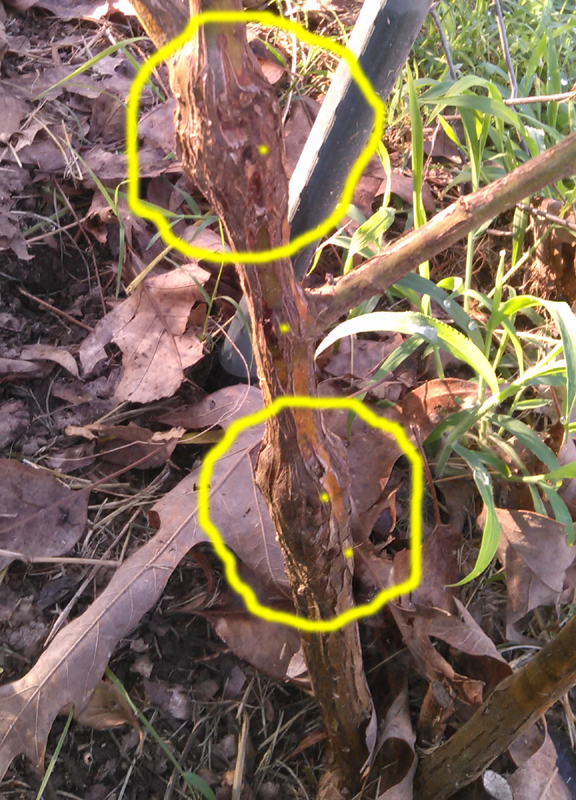Last year I cut canes completely out as soon as I saw the enlarged places until I only had a few canes left. These canes also enlarged so I decided to try drilling several holes in the knot and injecting Spinosad. If you look close the holes are still visible today. Normally this time of year the berry’s don’t mature properly from the damage but as of now the Natchez berry looks like they might be ok. If they mature properly I plan to cut the enlarged areas open. I might try a few with and without injections this year if these do ok. Bill
2015

2016

I hate Cane Borers, but I hate Crown Borers worse.
How do you like your Natchez blackberries? I have a couple that are sending up their first canes this year.
They are large and pretty good tasting and will sweeten up if you can let them hang long enough. Other than the borers they do well in my area. Natchez being thornless and ripening early is a big plus to me. I am in the process of narrowing my selections to PAF and Natchez. Bill
I’m north of you in NC and Natchez do well in my area too. You described the sweetness perfectly. Its a little tough to tell when the fruit is perfectly ripe, but after is hangs for a while its very sweet. Even sweeter than Navaho. I like the early fruit but the canes are more trailing and more difficult to manage than most of the Arkansas berry. I have found that they require more N than other Arkansas variety to get a strong cane and I have to tie the cane to the wire to keep a strong wind from blowing it over. I don’t have to tie the Ouachita or Navaho to the wire.
I have those borer bulges this year on my blackberry and my raspberry. Seems worse on raspberry this year. Anybody have ways to deal with these borers?
They are hard to deal with. Wild blackberries grow like weeds in my area so you would think they would be easy to grow here.
You give their growth habit a kinder description than I do. I’ve been known to curse them for shredding my ankles, embedding themselves in my hands when they are hiding at the base of another weed I’ve reached to pull, and strangling out wanted plants.
I can say couple of nice things about them:
Some of the kids like to pick and eat them.
They are drought tolerant.
Paired with green briar and poison ivy, they could be used effectively to create a dry moat as a security perimeter. ![]()
I’d be interested in any treatment for this pest that worked. At this point I just try to make sure the plants are highly vigorous, they can better heal around the galls if they are vigorous. Plants in full sun do a lot better than ones in part-shade in terms of dealing with the galls, and vigorous and well-adapted varieties also do better. In the last year I didn’t remove any canes that were not dead or fading, and I would guess I lost maybe 20% capacity from the gall damage. Many of my big canes now have galls but the cane is still fully vigorous. In the previous plantings of weaker varieties in less sun I would do a lot worse.
I think the borer is not right by the gall, they can be as low as the roots or as much as a couple feet above the gall. An injection the gall alone still may work due to high concentration.
You can see from the pictures I posted of the canes I split open that the actual borer moves around inside the cane. (if you look carefully you can see the brown paths they make)
Speaking of problems in the wild berry population, look what has shown up in a wild raspberry patch a few miles from my house:
…classic orange rust.
My PAF seem to have an affinity for that. ![]()
I really like Navaho but it gets rust bad. I dig the infected plants out as soon as I see it, but it gets a little worse each year.
This explains some of my lack of strong new canes especially after a good fruiting year. Thanks, Bill
My Natchez is massive. I don’t seem to have any nitrogen problems, although the native soil is very rich. Canes never have needed support. It’s the tallest of my blackberry plants for sure. I don’t have any good photos, hard to capture it, it is so massive. It is the one on the left with canes bending left. It started bending at 7 feet, and I guess is on a wire, so it does require some support. I basically put it on the top wire for ease of picking fruit. It’s right in front of my face. I could have cut it I guess at 4 feet and it would have had more laterals that would need support. It tends to grow to about 10 feet and stop, I never really headed this one. I may try it this year. It developed laterals without heading. Here it is just finishing flowering.
A neonic drench in early spring before pollenators are out has been working here .
What brand of neonic drench are you using? Thanks, Bill
i’ve just used a generic imadicloprid put out by winfield solutions. Oklahona State recommends a dry formulation put out by Bayer.
Thanks




